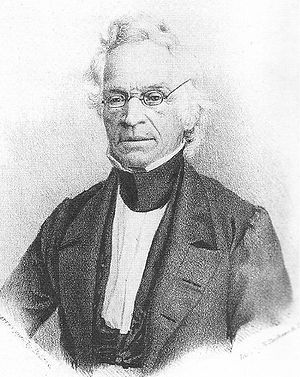
George Brown (Financier)
Encyclopedia

Investment banking
An investment bank is a financial institution that assists individuals, corporations and governments in raising capital by underwriting and/or acting as the client's agent in the issuance of securities...
and railroad entrepreneur. He emigrated from Ulster
Ulster
Ulster is one of the four provinces of Ireland, located in the north of the island. In ancient Ireland, it was one of the fifths ruled by a "king of over-kings" . Following the Norman invasion of Ireland, the ancient kingdoms were shired into a number of counties for administrative and judicial...
to Baltimore, Maryland, at the age of 15 in 1802.
He eventually joined his father, Alexander Brown (1764–1834), in the family business, Alex. Brown & Sons
Alex. Brown & Sons
Alex. Brown & Sons was the first investment bank in the United States, founded by Alexander Brown in 1800 and based in Baltimore, Maryland. The firm was acquired by Bankers Trust in 1997 to form BT Alex...
, which became one of the leading investment banks of the U.S. in the nineteenth century. In 1818, George partnered with his brother John in starting the firm of Brown Bros. & Co.
Brown Bros. & Co.
Brown Bros. & Co. was an investment bank from 1818 until its merger with Harriman Brothers & Company in 1931 to form Brown Brothers Harriman & Co.-History:...
in Philadelphia, Pennsylvania
Philadelphia, Pennsylvania
Philadelphia is the largest city in the Commonwealth of Pennsylvania and the county seat of Philadelphia County, with which it is coterminous. The city is located in the Northeastern United States along the Delaware and Schuylkill rivers. It is the fifth-most-populous city in the United States,...
.
George Brown had a prominent role in the founding of the Baltimore and Ohio Railroad (B&O)
Baltimore and Ohio Railroad
The Baltimore and Ohio Railroad was one of the oldest railroads in the United States and the first common carrier railroad. It came into being mostly because the city of Baltimore wanted to compete with the newly constructed Erie Canal and another canal being proposed by Pennsylvania, which...
, the first common carrier
Common carrier
A common carrier in common-law countries is a person or company that transports goods or people for any person or company and that is responsible for any possible loss of the goods during transport...
railroad in the U.S. On February 12, 1827, he hosted a meeting at his Baltimore home for 24 leading merchants, where Philip E. Thomas
Philip E. Thomas
Philip Evan Thomas was the first president of the Baltimore and Ohio Railroad from 1827-1836. He has been referred to as "The Father of American Railways." The Thomas Viaduct bridge in Relay, Maryland was named after him....
joined Brown in advocating the formation of a railroad to make Baltimore competitive with other eastern seaboard ports. Concerned at the potential effect of canal
Canal
Canals are man-made channels for water. There are two types of canal:#Waterways: navigable transportation canals used for carrying ships and boats shipping goods and conveying people, further subdivided into two kinds:...
s, particularly the successful Erie Canal
Erie Canal
The Erie Canal is a waterway in New York that runs about from Albany, New York, on the Hudson River to Buffalo, New York, at Lake Erie, completing a navigable water route from the Atlantic Ocean to the Great Lakes. The canal contains 36 locks and encompasses a total elevation differential of...
(completed in 1825) and others being planned, such as the C&O Canal
Chesapeake and Ohio Canal
The Chesapeake and Ohio Canal, abbreviated as the C&O Canal, and occasionally referred to as the "Grand Old Ditch," operated from 1831 until 1924 parallel to the Potomac River in Maryland from Cumberland, Maryland to Washington, D.C. The total length of the canal is about . The elevation change of...
to Washington, D.C.
Washington, D.C.
Washington, D.C., formally the District of Columbia and commonly referred to as Washington, "the District", or simply D.C., is the capital of the United States. On July 16, 1790, the United States Congress approved the creation of a permanent national capital as permitted by the U.S. Constitution....
, he served on the committee which studied the development of railroads in Great Britain
Great Britain
Great Britain or Britain is an island situated to the northwest of Continental Europe. It is the ninth largest island in the world, and the largest European island, as well as the largest of the British Isles...
. At a subsequent meeting in Brown's house (near where Baltimore's City Hall now stands), the committee concluded that the then-unproven technology of a long-haul railroad was feasible and that considerable trade "would flow into the State of Maryland, upon the proposed Rail Road," the committee's report concluded.The state agreed, approving a charter for the B&O Railroad on March 13, 1827. Thereafter, the Mechanics Bank of Baltimore, where George Brown and Philip E. Thomas were officers, had a leading role in the financing and sale of B&O stock for construction of the first railroad in the U.S.
George Brown was subsequently elected as the B&O's first treasurer. He later succeeded his father in 1834 as head of Alex. Brown & Sons.
The Brown Memorial Presbyterian Church
Brown Memorial Presbyterian Church
Brown Memorial Park Avenue Presbyterian Church of Baltimore, Maryland, U.S., is a large, Gothic Revival-style church built in 1870 and located at Park and Lafayette Avenues in the city's Bolton Hill section...
of Baltimore, Maryland was built in 1870 in his memory, funded by Brown's wife, Isabella McLanahan Brown. His brothers were William
Sir William Brown, 1st Baronet, of Astrop
Sir William Brown, 1st Baronet was a British merchant and banker, founder of the banking-house of Brown, Shipley & Co...
, John, and James.

